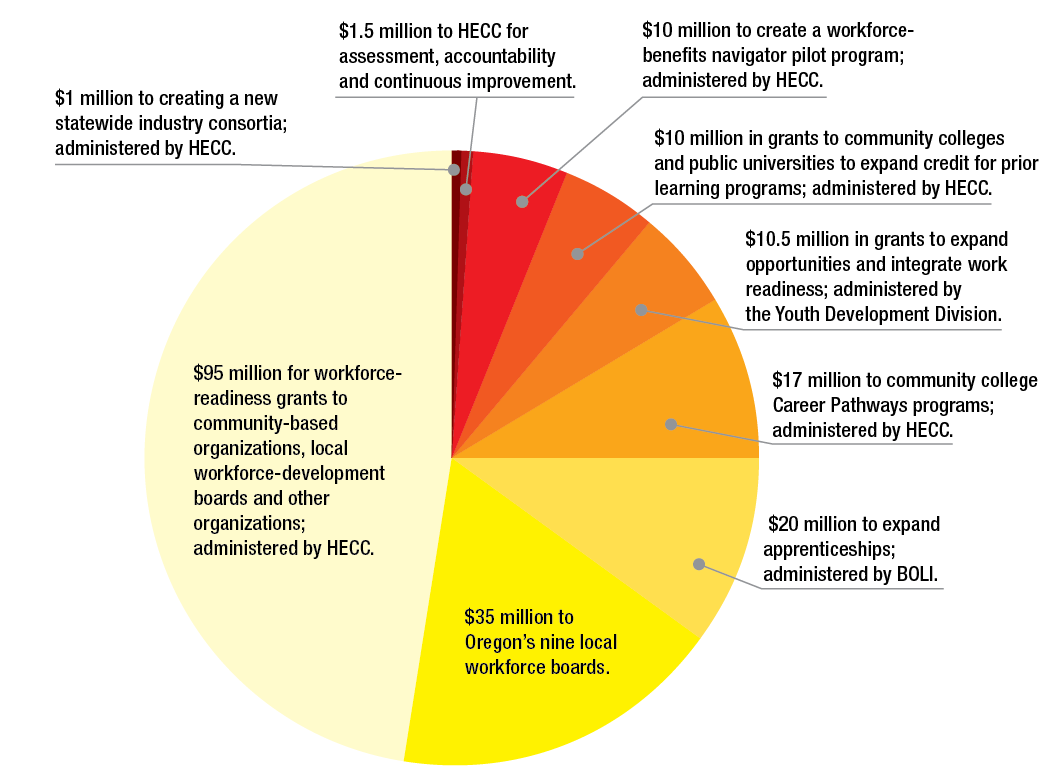Senate Bill 1545, also known as Future Ready Oregon, promises to shore up a dire labor shortfall. Does it make the grade?
Manny Jimenez was a good student with ambitious dreams, but after his (virtual) graduation from Sherwood High School in 2020, he floundered.
Investing four years in a costly bachelor’s degree never made sense to him. “Too expensive,” he explains. “I opted out of taking the ACTs.”
But his hope of jumping into an apprenticeship with the electrical trades proved just as elusive. “They are really hard to get into. You have to come with experience and a portfolio,” he says.
So Jimenez spent a year on the sidelines. He stayed busy, looking after his five younger siblings, pitching in at home after his grandfather suffered a stroke and working a part-time job at Home Depot. He even tried to take a community college course to help him build that necessary portfolio, but all the classes were full. Meanwhile, his dream of landing a lucrative career in the trades seemed further out of reach.
Then he met Talina Villao. As a career coach for Portland Community College’s Career Pathways program, Villao pointed Jimenez to the heating, ventilation, air-conditioning and refrigeration certification program. She helped him secure financial aid for tuition, books and $500 worth of tools. Villao even handed him a loaded Hop transit pass so Jimenez could make the two-hour-each-way commute to PCC’s Swan Island Trades Center for hands-on instruction.
Eleven weeks later, 20-year-old Jimenez completed the training necessary to earn certification as an HVAC/R installer. He’s already signed up to earn another certificate, this time in pre-trades. After that, well, Jimenez is examining his many options.
 Manny Jimenez demonstrates skills learned in his HVAC class. Photo: Jason E. Kaplan
Manny Jimenez demonstrates skills learned in his HVAC class. Photo: Jason E. Kaplan
“I could jump into an apprenticeship or maybe I’ll get a construction-management degree,” he muses.
Jimenez is the poster child for how the Career Pathways programs at Oregon’s community colleges are supposed to work. Already highly successful — PCC reports that the two most recent cohorts had a combined 88% completion rate, 90% for BIPOC students — the program matches prospective students to a career coach who guides them through the labyrinth of certification options, available services and monetary aid to quickly land living-wage employment.
This pipeline just received a cash infusion in the form of SB 1545, also known as Future Ready Oregon. The bill invests $200 million into a variety of proven and new workforce-development schemes (see sidebar, p.31, for a breakdown) with a good portion going to Career Pathways programs and, more importantly, the wraparound support services that make career training a realistic option for disadvantaged, cost-burdened students.
At a time when community college enrollment is down, historically marginalized people continue to suffer from the effects of the pandemic, and a labor shortage has industries scrambling, Future Ready Oregon looks like a win/win/win for students, the institutions that train them and the businesses that desperately need workers.
Investing in the trades is an idea that is gaining traction throughout the nation. NPR reported at the end of March that more than a million students opted out of college during the pandemic, with two-year public schools taking the hardest hit. At the same time, enrollment in skilled-trade programs is booming, according to the same report.
Future Ready Oregon strives to keep that momentum going with a laser focus on equity. The bill was written with input from the Racial Justice Council, an advisory group that focuses on helping the historically marginalized including women, BIPOC, rural and low-income students.
“As a colleague of mine says, ‘Talent is universal, but opportunity is not,’” recalls Portland Community College president Mark Mitsui. Mitsui also serves on the Racial Justice Council Workforce Workgroup. (In April 2021, Mitsui announced that he planned to retire at the end of the calendar year. As this issue went into production in early April, the college announced it had hired Adrien Bennings after a nine-month national search.) “This bill is about making opportunity universal.”
 Portland Community College president Mark Mitsui, who will be retiring in June. Photo: James Hill, Portland Community College
Portland Community College president Mark Mitsui, who will be retiring in June. Photo: James Hill, Portland Community College
Oregon’s need for a skilled labor pool is also universal. The state estimated a deficit of some 300,000 workers with post-secondary certifications — meaning beyond a high school education — back in 2020. The pandemic squeezed that pipeline tighter.
Officials drafted SB 1545 as a two-pronged solution to that shortage. One prong will help build the capacity to certify more workers for health care, manufacturing, technology and construction jobs.
“Running these programs is expensive,” explains John Wykoff, deputy director of the Oregon Community College Association. “This investment will allow community colleges throughout the state to update their equipment and add more capacity.”
The money will also help hire more career coaches like Talina Villao. Villao and her colleagues at PCC already serve about 300 students. They would like to hire at least one more coach to inch that number up to 400 by October 1, according to Christina Shafer, interim Career Pathways and STEP manager.
The goals for rural community colleges are more modest but just as impactful. The program at Treasure Valley Community College in Ontario, for instance, only serves 20 students at present. Funds from Future Ready Oregon could double that number according to Treasure Valley Community College president Dr. Dana Young.
But adding extra seats and obtaining state-of-the-art equipment doesn’t mean much for cost-burdened students. “The minute someone registers for one of these programs, they are making a sacrifice,” says Villao. “They can no longer work full-time. So how do they support themselves and their families and still invest in their future?”
The bill’s second prong will ease that burden by providing funds for what the student needs to succeed. The help could come in many forms: money for child care, help with housing costs or, as was the case with Jimenez, cash for tuition, books, tools and transportation. To access these services, career coaches would help students sign up for the Supplemental Nutrition Assistance Program, aka SNAP benefits. That part can be hard.
“There’s a stigma around SNAP that I work to remove,” says Villao. “I just talk about it like another piece of financial aid.”
Once on SNAP, students can stack on STEP, which stands for SNAP Training & Employment Program, to access more funds and resources.
Young is very excited about what this bill could do for the students her school serves. “We have the highest poverty rate in Oregon and the highest ratio of underrepresented students of color,” she says, pointing to a large population of Hispanic migrant farm workers.
“A lot of these students are not familiar with the language of ‘financial aid’ or a ‘GED.’ They may need remediation to get up to speed with math, reading or English. This will help us meet them where they are.”
Future Ready Oregon received overwhelming support in the Oregon Legislature, passing 48 to 10 in the House and 23 to 3 in the Senate.
Public testimony on the bill was largely favorable, with education and advocacy groups — including Associated Oregon Loggers and SEIU — largely testifying in favor of the bill.
Some groups asked that the bill’s focus be expanded — the Northwest Automotive Trades Association’s Darrell Fuller, for example, submitted written testimony requesting that the state add training for service and repair of motor vehicles.
Testimony from Oregon Business & Industry included measured criticism of the bill, saying it lacked specifics and accountability metrics — and that it should make funding available directly to employers through public-private partnerships.
Asked for comment on the bill after passage, Morgan Beltz, the group’s public-affairs associate, sent the following statement to Oregon Business: “We’re encouraged that the Governor and the Legislature have recognized the need to invest in workforce training. The implementation of Future Ready Oregon is in the very early stages, however, and many details have yet to be worked out. We want to ensure that employers have a seat at the table during implementation, and we hope that programs supported by Future Ready Oregon funding address employers’ near-term workforce needs to the extent possible.”
Just one of the legislators who voted against the bill responded to a request for comment from OB.
“Gov. Brown chose to spend $200 million in federal and state money on a workforce- development program for suffering Oregonians that divides them based on race and gender,” wrote Rep. Jessica George (R-Keizer) in an emailed statement. “When people are down on their luck, to have their state government say we aren’t going to help you based on your race or gender is inequitable and immoral. If we have Oregonians in need, we should help them equally to get back on their feet to get a job. We shouldn’t leave people behind.” (George was appointed to replace Rep. Bill Post in December following Post’s resignation and subsequent move to Nevada.)
One critic who ultimately supported the bill was Rep. Paul L. Evans (D-Monmouth), who took issue with the fact that the Higher Education Coordinating Commission is tasked with administering most of the funds and tracking the plan’s success.
“I believe HECC is uniquely unqualified for the mission it has been tasked with,” Evans wrote in response to an emailed request for comment. “Historically, the Higher Education Coordinating Commission has had a terrible record of supporting anything beyond traditional ‘academic’ learning environments.”
Julia Steinberger, interim director of the office of Workforce Investments at the HECC, respectfully disagrees. She points to a longstanding partnership with the Oregon Bureau of Labor & Industries that she says will “continue and strengthen. More broadly, HECC has a long history of administering and supporting workforce development, making us well suited to implement a package like this.”
Wykoff, from OCCA, adds that community colleges can bring those other resources that help with the soft costs of college to bear, while BOLI cannot.
“Also, these programs are not apprenticeships but short-term stackable certificates that lead to jobs and further degrees,” Wykoff says.
And yet, many of Oregon’s public colleges and universities are going through embarrassing public shakeups involving university president resignations, early retirements and votes of no confidence. And HECC, which was created in 2011 and trusted with financial oversight of the state higher education system two years later as the Oregon University System was dissolved, has received criticism about transparency and responsiveness.
The result: Many people are skeptical of HECC.
Still, Evans voted for Future Ready Oregon.
“There was far more good in the bill than bad, and as someone who has spent much of [his] lifetime in education, I could not in good conscience vote against the omnibus measure,” he writes.
Shoring up Career Pathways and STEP support makes sense. But it is just a small part of filling a 300,000-person gap of trained workers. To meet the need, Future Ready Oregon is investing in other venues as well including state workforce boards, regional workforce investment boards, registered apprenticeships, community-based organizations, and even career technical education in K-12 schools.
“It’s a large constellation of actors,” says PCC president Mitsui.
Sidebar: A HECC of an Investment
Just a small part of the $200 million budget for SB 1545, aka Future Ready Oregon, is directly allocated to community college Career Pathways programs. This leaves plenty of money to fund other, innovative solutions. While the approaches are varied, the goals are the same: Build a pipeline for short-term success that centers disadvantaged populations. Here is a primer about how the $76.9 million from Oregon’s general fund and the $123.1 million contribution from the federal American Rescue Plan is being spent and who holds the purse strings.

• Oregon’s nine local workforce boards will receive a $35 million investment to be used for start-to-finish career coaching, earn and learn opportunities to “re-career,” and funds for wraparound supports and services like help with housing, child care and transit.
• HECC will administer $17 million to community college Career Pathways programs. These programs offer the certificates, like the HVAC/R tech certificate that Manny Jimenez earned, that allow students to move quickly into entry-level employment or advancement in high-wage, high-demand jobs.
• Twenty million dollars is earmarked to expand apprenticeships. BOLI will administer grants that diversify apprenticeships, provide help with tuition and fees, and offer stipends, wages and vital wraparound services.
• Organizations that work with disconnected youth will compete for $10.5 million in grants to expand opportunities and integrate work readiness and experience. The money is administered by the Youth Development Division.
• Community colleges and public universities are offered $10 million in grants to expand credit for prior learning programs. These funds will be administered by HECC.
• A whopping $95 million is earmarked for workforce readiness grants. HECC will administer grants to community-based organizations, local workforce development boards and other organizations who in turn will provide direct financial benefits to individuals, develop education and training pathways, and build organizational capacity.
• HECC will administer $10 million to create a workforce- benefits navigator pilot program. These navigators will serve as a single point of contact and be aware and attentive of cultural differences and lived experiences.
• One million dollars is dedicated to creating a new statewide industry consortia. These HECC administered funds will create a health care, manufacturing and construction consortia designed to create efficiencies, identify needs and focus on worker/employer ROI.
• HECC gets $1.5 million for assessment, accountability and continuous improvement. They will use funds to increase capacity and infrastructure, conduct assessments and communicate findings.
To subscribe to Oregon Business, click here.







